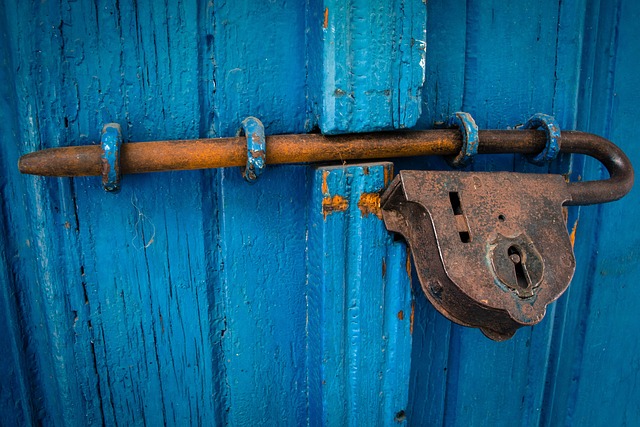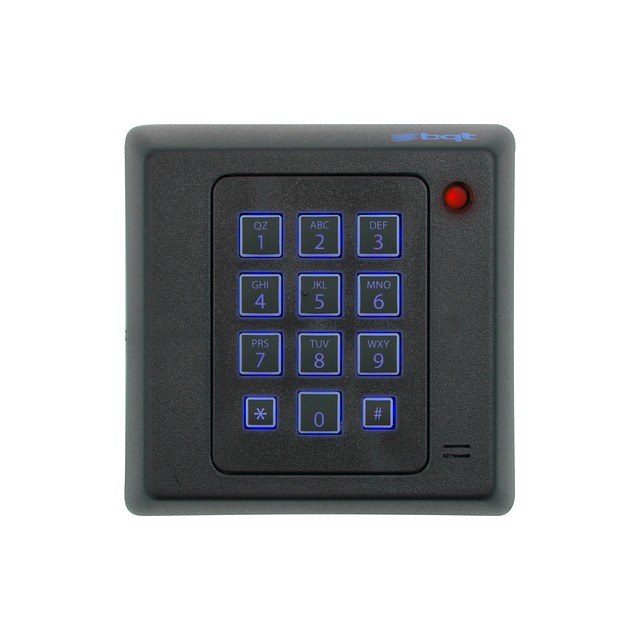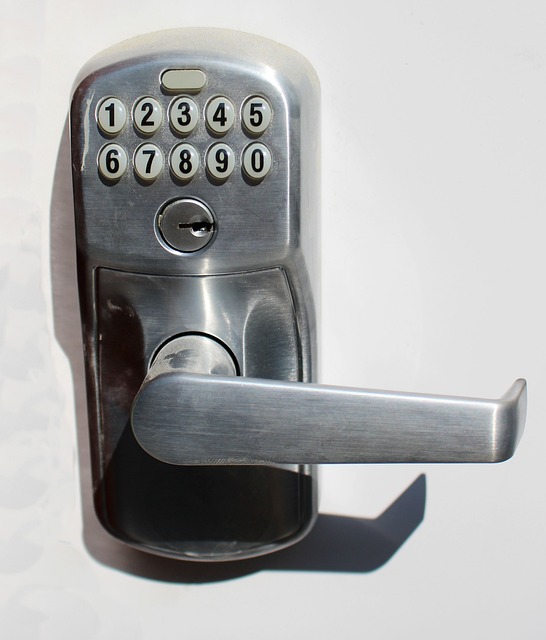Smart locks and keyless door locks have revolutionized home security and convenience by offering advanced access control systems that replace traditional keys with sophisticated entry methods like biometrics, PIN codes, or mobile device connectivity. These systems enhance user flexibility, provide heightened security through features such as remote operation, real-time alerts, and temporary access permissions, and are becoming more intuitive to balance security and convenience effectively. The adoption of these smart access controls is a significant leap forward, allowing homeowners to manage their property's access remotely while ensuring state-of-the-art protection against unauthorized entry. The integration of Multi-Factor Authentication (MFA) further bolsters security by requiring users to provide two or more verification factors, deterring unauthorized access and protecting against cyber threats. As technology continues to evolve, smart locks remain at the forefront of home automation, ensuring that homes are equipped with the latest in secure, user-friendly access control systems, future-proofing against new security challenges with consistent software updates. These advancements not only make it easier for residents to manage their home entries but also offer a reliable barrier against potential intruders, keeping homes safe with the most current security technology.
Welcome to the future of home security and convenience. In this article, we explore the transformative impact of upgrading your home entry with smart access controls, a pivotal shift from traditional keys to advanced keyless door locks. We delve into the intricacies of what constitutes smart access controls, the myriad benefits they offer, and how you can choose the right system for your home. From understanding the basics of access control systems to implementing robust multi-factor authentication, we’ll guide you through the process of securing your home with cutting-edge smart lock technology. Join us as we unlock the potential of a smarter, safer, and more connected living space.
- Understanding Smart Access Controls for Home Entry
- The Advantages of Installing a Keyless Door Lock
- Evaluating Smart Lock Options for Your Home
- Implementing Multi-Factor Authentication in Smart Access Systems
- Future-Proofing Your Home with Advanced Access Control Solutions
Understanding Smart Access Controls for Home Entry

Smart access controls represent a significant advancement in home security and convenience, offering homeowners a modern alternative to traditional keys and locks. A smart lock, which is a key component of this ecosystem, facilitates keyless door lock entry through various methods such as biometric identification, PIN codes, or mobile devices. These sophisticated systems not only enhance user accessibility but also provide a higher level of security with features like remote locking and unlocking, real-time alerts, and the ability to grant temporary access. Users can customize permissions and monitor who enters their home, all from an app on their smartphone. The integration of smart access controls is a testament to the evolution of home entry systems, aligning with the growing need for security and ease of management in residential settings. Homeowners can rest assured that their property is protected with a level of precision and control previously unattainable. Moreover, these systems often come with auto-lock functionality to ensure the door locks itself after a set period of time, adding an additional layer of security against unwanted intrusions. With continuous advancements in technology, smart access controls are becoming increasingly user-friendly, offering homeowners a seamless blend of high-security standards and convenience for their daily lives.
The Advantages of Installing a Keyless Door Lock

The integration of a smart lock as an access control system in homes offers numerous advantages over traditional key-based locks. For starters, it provides unparalleled convenience by eliminating the need to carry physical keys. Homeowners can grant temporary access to visitors, service personnel, or family members without the risk of keys being lost or copied, thereby maintaining strict control over who enters their home and when. Additionally, smart locks are inherently more secure than traditional locks; they often come equipped with encryption and tamper detection features, ensuring that your home entry is safeguarded against forced entry attempts or digital intrusions. With the capability to receive updates and operate remotely, users can stay informed of who has accessed their property and when, all from the convenience of a smartphone app. This level of access control not only enhances security but also affords homeowners peace of mind, knowing that their home is secure against unauthorized entry at all times.
Moreover, smart locks facilitate seamless integration with other smart home systems, creating a network of devices that can communicate and work in tandem to provide an even higher level of security. For instance, if paired with a smart home security system, the lock can be set to activate alarms or notify homeowners of attempted break-ins. The convenience and security features of smart locks extend beyond personal use; they also streamline access for residents, simplifying daily routines such as letting oneself into the home after a workout at the gym or allowing a child to enter without carrying keys. This modern approach to keyless door locks is not just a trend but a transformative step towards smarter and more secure living spaces.
Evaluating Smart Lock Options for Your Home

When considering an upgrade to your home’s entry system with smart access controls, evaluating the plethora of smart lock options available is crucial. Access control technology has advanced significantly, offering a variety of keyless door lock solutions tailored to diverse security and convenience needs. Factors such as compatibility with existing home automation systems, robustness against unauthorized access, user-friendliness, and integration capabilities should guide your decision. Smart locks come in various forms, including biometric models that use fingerprints, keypad models for passcode entry, and those compatible with smartphones or wearables, which allow for remote access and control. It’s important to assess the security features of each option, such as encryption methods, authentication processes, and connectivity options like Bluetooth, Wi-Fi, or Z-Wave, to ensure your home is protected against both physical and cyber threats. Additionally, user experience plays a pivotal role; consider ease of installation, reliability, and the ability to create temporary access codes for guests or service providers. By carefully evaluating these aspects, you can select a smart lock that not only enhances your home’s security but also integrates seamlessly into your daily routine.
Implementing Multi-Factor Authentication in Smart Access Systems

In the realm of home security, upgrading to smart access controls with Multi-Factor Authentication (MFA) represents a significant leap forward in protecting one’s residence. A keyless door lock that integrates MFA requires users to present two or more forms of identification before granting entry, significantly enhancing the security protocol beyond mere password protection. This layered approach deters unauthorized access and safeguards against potential vulnerabilities inherent in single-factor systems, such as traditional keyless door locks. For instance, even if a malicious actor were to intercept a passcode, they would still need to bypass the additional authentication factor, which could be anything from a biometric print to a one-time code sent to a trusted device. This robust security measure ensures that only authorized users can access the home, providing peace of mind for homeowners looking to integrate smart technology into their daily lives.
The implementation of MFA in smart locks is not without its nuances. It’s a balance between convenience and enhanced security, with systems designed to be user-friendly while offering a defensive layer against intrusion attempts. The process typically involves setting up the system through a dedicated app, which allows users to manage different access codes and authentication methods. This setup can include fingerprint scanning, facial recognition, or even voice recognition in addition to traditional PIN codes or smartphone-based keys. The integration of MFA with smart locks also facilitates remote management, enabling homeowners to provide temporary access for service personnel, family members, or guests without being physically present. This feature underscores the versatility and adaptability of modern access control systems, making them an invaluable addition to any smart home setup.
Future-Proofing Your Home with Advanced Access Control Solutions

As homes evolve into more integrated and intelligent environments, future-proofing your residence with advanced access control solutions becomes paramount. Smart locks and keyless door locks represent the forefront of this evolution, offering a blend of enhanced security and user convenience. These innovative devices not only provide a seamless entry experience through biometric verification or digital keys but also integrate with broader home automation systems for centralized management. By adopting smart access controls, homeowners can rest assured that their property is equipped with the latest in security technology, ready to adapt to future advancements and maintain its relevance in an ever-changing landscape of home safety and efficiency.
The integration of smart locks into your home security system ensures a robust defense against unauthorized entry while offering the flexibility to grant access remotely. With capabilities that allow for temporary passcodes, remote unlocking via smartphone applications, and real-time activity notifications, these keyless door lock systems represent a significant leap forward in both access control technology and convenience. Furthermore, as these systems often come with regularly updated software, they continuously evolve to counter new security threats, ensuring that your home remains protected against emerging vulnerabilities. This proactive approach to home security not only safeguards your property but also offers peace of mind, knowing that your access control system is at the cutting edge of technology and prepared for the future.
In conclusion, upgrading your home entry with smart access controls offers a multitude of benefits, from the convenience of a keyless door lock to the heightened security provided by multi-factor authentication. As the landscape of home entry systems evolves, incorporating advanced access control solutions not only enhances your home’s security but also positions it for future technological advancements. By thoughtfully evaluating and implementing smart lock options tailored to your needs, you can significantly improve the accessibility and safety of your home. The future of home entry is undoubtedly keyless, and with the right system in place, you can rest assured knowing that your home’s access control is both current and future-proof.
